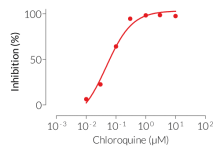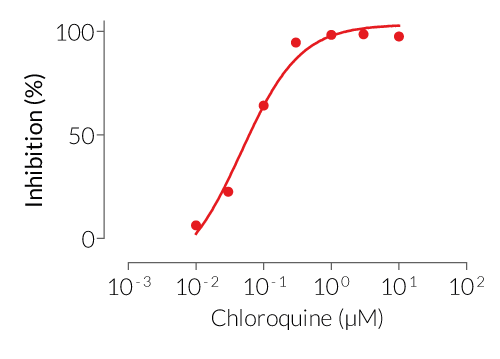Chloroquine
| Product | Unit size | Cat. code | Docs. | Qty. | Price | |
|---|---|---|---|---|---|---|
|
Chloroquine Inhibitor of endosomal acidification - InvitroFit™ |
Show product |
4 x 250 mg |
tlrl-chq-4
|
|
Endosomal acidification and autophagy inhibitor

Endosomal acidification and autophagy inhibitor
Chloroquine is a lysosomotropic agent that was historically developed as an anti-malarial treatment. However, it has become a widely used inhibitor for studying autophagy and the role of endosomal acidification in cellular processes, such as in intracellular TLR9 signaling.
Mode of action:
Chloroquine passively diffuses into cellular acidic compartments, including endosomes, Golgi vesicles, and lysosomes, where it accumulates as a protonated form. This results in an increase of the intravesicular pH, and the inhibition of several enzymes that require an acidic pH for proper functioning. Thus, chloroquine prevents the maturation and fusion of endosomes and lysosomes [1].
Key features:
- Extensively used in the literature as an endosomal acidification and autophagy inhibitor
- InvitroFit™ grade: highly pure (≥98%) and inhibitory function validated in cellular assays
Chloroquine provided by InvivoGen is for research use only.
COVID-19 related research
Coronaviruses, such as SARS-CoV and presumably SARS-CoV-2, enter and traffic through the host cell in endosomes. Targeting endosomal acidification and intracellular trafficking with chloroquine is one of the strategies to limit SARS-CoV-2 infection.
References:
1. Ducharme J. & Farinotti, R., 1996. Clinical pharmacokinetics and metabolism of chloroquine. Focus on recent advancements. Clin Pharmacokinet 31, 257-274.
Back to the topSpecifications
Working concentration: 10 μM
CAS number: 50-63-5
Synoym: N4-(7-Chloro-4-quinolinyl)-N1,N1-dimethyl-1,4- pentanediamine diphosphate salt
Solubility: 50 mg/ml in water
Molecular weight: 515.86 g/mol
Quality control:
- Purity: ≥98% (UHPLC)
- The inhibitory activity has been validated using cellular assays.
- The absence of bacterial contamination (e.g. lipoproteins and endotoxins) has been confirmed using HEK-Blue™ hTLR2 and HEK-Blue™ hTLR4 cells.
Contents
- 4 x 250 mg Chloroquine (diphosphate salt)
![]() Chloroquine is shipped at room temperature.
Chloroquine is shipped at room temperature.
![]() Store at room temperature (15-25°C). Protect from light.
Store at room temperature (15-25°C). Protect from light.
Back to the top
Details
Chloroquine has an extensive range of biological effects. Due to its well-studied toxicity profile, chloroquine is one of the only autophagy inhibitors approved for use in the clinic [1]. Modulation of autophagy by chloroquine has been shown to have the potential in delaying the onset and/or enhancing therapies for various pathologies such as cancer, chronic obstructive pulmonary disease (COPD), and inflammatory diseases. Specifically, it has been shown, in vitro and in vivo, that chloroquine has a detrimental effect on the basal autophagic flux by decreasing autophagosome-lysosome fusion due to the impaired function of essential hydrolases [2].
Chloroquine impairs the replication of several viruses, including members of flaviviruses, retroviruses, and coronaviruses, by inhibiting the necessary endosome acidification upon endosomal-mediated viral entry and vesicle trafficking in the later stages of infection (i.e. through the ER-Golgi and exocytosis from the cell) [3, 4]. A subset of Toll-like receptors (TLRs), TLR3, TLR7/8, and TLR9, is involved in antiviral responses by triggering the production of antiviral cytokines such as type I interferons (IFNs). TLR3 responds to double-stranded RNA, a replication intermediary for many viruses. TLR7/8 recognize viral single-stranded RNAs, whereas TLR9 recognizes unmethylated CpG motifs within viral DNA [5]. Of note, the TLRs involved in virus recognition are expressed on endosomal membranes.
Notably, chloroquine is used routinely in the clinic for inflammatory conditions such as rheumatoid arthritis (RA) and systemic lupus erythematosus (SLE) [6]. The accumulation of chloroquine in lymphocytes and macrophages decreases the production of pro-inflammatory cytokines, specifically TNF-α, and results in anti-inflammatory properties [3].
References:
1. Solitro A.R. & MacKeigan J.P., 2016. Leaving the lysosome behind: novel developments in autophagy inhibition. Future Med Chem. 8(1):73-86.
2. Mauthe M. et al., 2018. Chloroquine inhibits autophagic flux by decreasing autophagosome-lysosome fusion. Autophagy 14(8):1435-1455.
3. Savarino A. et al., 2003. Effects of chloroquine on viral infections: an old drug against today's diseases? Lancet Infect Dis 3, 722-727.
4. Wang M. et al., 2020. Remdesivir and chloroquine effectively inhibit the recently emerged novel coronavirus (2019-nCoV) in vitro. Cell Res 30, 269-271.
5. Boehme KW. & Compton T., 2004.Innate sensing of viruses by toll-like receptors. J Virol 78, 7867-7873.
6. Al-Bari M.A., 2015. Chloroquine analogs in drug discovery: new directions of uses, mechanisms of actions, and toxic manifestations from malaria to multifarious diseases. J Antimicrob Chemother 70, 1608-1621.
Chemical structure of Chloroquine (diphosphate)







